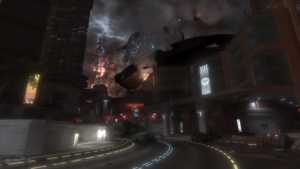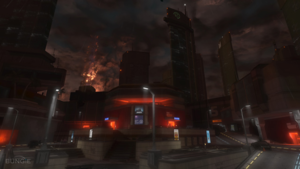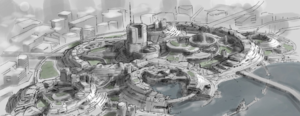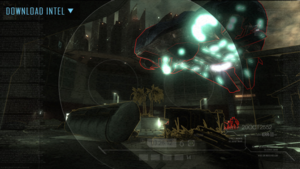Archive:Bungie.net/Halo 3: ODST: Field Guide: Difference between revisions
From Halopedia, the Halo wiki
BaconShelf (talk | contribs) (need to sort out images but this should do nicely for now) |
BaconShelf (talk | contribs) mNo edit summary |
||
| Line 5: | Line 5: | ||
==Page content== | ==Page content== | ||
<center>''This is a word-by-word replica of the [https://web.archive.org/web/20130525021451/http://halo.bungie.net/projects/odst/guide.aspx original page] at Bungie.net. All typos and discrepancies are included as originally written.''</center> | <center>''This is a word-by-word replica of the [https://web.archive.org/web/20130525021451/http://halo.bungie.net/projects/odst/guide.aspx original page] at Bungie.net. All typos and discrepancies are included as originally written.''</center> | ||
=== | ===Intel=== | ||
{| class="wikitable" style="width:55%" | {| class="wikitable" style="width:55%" | ||
|- | |- | ||
| Line 11: | Line 11: | ||
[[File:CIV-Superintendent-logo1.png|300px|center]]<br></div></div> | [[File:CIV-Superintendent-logo1.png|300px|center]]<br></div></div> | ||
|- | |- | ||
| <div class="toccolours mw-collapsible mw-collapsed">'''NEW MOMBASA'''<div class="mw-collapsible-content">Two hundred and fifty years ago [[New Mombasa]]—at that time the world's busiest sea port—was chosen to be [[Earth]]'s first [[Space elevator|tether city]]. Over the next eleven years the city experienced explosive growth, but nothing compared to what followed. The city grew out as well as up, its urban sprawl unequaled throughout [[Africa|the continent]]. By [[2430]] New Mombasa had absorbed all of the island and many of the surrounding towns found themselves overrun by residents of the old city. The switch was never official and many of the neighborhoods within direct line of sight to the [[Mombasa Tether]] still distribute newspapers and [[ChatterNet|chatter directories]] under their "old" names, but all municipalities within a 74 km radius of the island are now referred to as [[Old Mombasa]]. | | <div class="toccolours mw-collapsible mw-collapsed">'''NEW MOMBASA'''<div class="mw-collapsible-content">Two hundred and fifty years ago [[New Mombasa]]—at that time the world's busiest sea port—was chosen to be [[Earth]]'s first [[Space elevator|tether city]]. Over the next eleven years the city experienced explosive growth, but nothing compared to what followed. The city grew out as well as up, its urban sprawl unequaled throughout [[Africa|the continent]]. By [[2430]] New Mombasa had absorbed all of the island and many of the surrounding towns found themselves overrun by residents of the old city. The switch was never official and many of the neighborhoods within direct line of sight to the [[Mombasa Tether]] still distribute newspapers and [[ChatterNet|chatter directories]] under their "old" names, but all municipalities within a 74 km radius of the island are now referred to as [[Old Mombasa]]. | ||
| Line 23: | Line 19: | ||
[[File:H3ODST FieldGuide NewMombasa Concept.png|300px|center]]<br> | [[File:H3ODST FieldGuide NewMombasa Concept.png|300px|center]]<br> | ||
[[File:H3ODST FieldGuide Download NewMombasa.png|300px|center]]</div></div> | [[File:H3ODST FieldGuide Download NewMombasa.png|300px|center]]</div></div> | ||
|- | |- | ||
| <div class="toccolours mw-collapsible mw-collapsed">'''HEALTH PACK/OPTICAN'''<div class="mw-collapsible-content">ATTENTION ALL UNSC PERSONNEL: Due to the ongoing evacuation efforts all health care personnel have been relocated to the [[Mombasa Quays]] area until which time they can be disembarked on outbound [[Human marine craft|sea craft]]. In the unlikely event that you become separated from your unit or cannot contact a medic look for one of the many [[Optican]]™ MediGel™ First Aid stations around the city. | | <div class="toccolours mw-collapsible mw-collapsed">'''HEALTH PACK/OPTICAN'''<div class="mw-collapsible-content">ATTENTION ALL UNSC PERSONNEL: Due to the ongoing evacuation efforts all health care personnel have been relocated to the [[Mombasa Quays]] area until which time they can be disembarked on outbound [[Human marine craft|sea craft]]. In the unlikely event that you become separated from your unit or cannot contact a medic look for one of the many [[Optican]]™ MediGel™ First Aid stations around the city. | ||
| Line 32: | Line 24: | ||
[[File:H3ODST FieldGuide HealthPack 1.png|300px|center]]<br> | [[File:H3ODST FieldGuide HealthPack 1.png|300px|center]]<br> | ||
[[File:H3ODST_FieldGuide_HealthPack_2.png|300px|center]]</div></div> | [[File:H3ODST_FieldGuide_HealthPack_2.png|300px|center]]</div></div> | ||
|- | |- | ||
| <div class="toccolours mw-collapsible mw-collapsed">'''ORBITAL DROP SHOCK TROOPER'''<div class="mw-collapsible-content">[[United Nations Space Command]] (UNSC) [[Orbital Drop Shock Trooper]]s (ODST) are under the operational authority of [[Naval Special Weapons]] (NavSpecWeap). Their methods of operation allow them to conduct missions against targets that more conventional forces cannot approach undetected. | | <div class="toccolours mw-collapsible mw-collapsed">'''ORBITAL DROP SHOCK TROOPER'''<div class="mw-collapsible-content">[[United Nations Space Command]] (UNSC) [[Orbital Drop Shock Trooper]]s (ODST) are under the operational authority of [[Naval Special Weapons]] (NavSpecWeap). Their methods of operation allow them to conduct missions against targets that more conventional forces cannot approach undetected. | ||
Revision as of 15:27, July 17, 2023
| The following is a verbatim transcription of an official document for archival reasons. As the original content is transcribed word-for-word, any possible discrepancies and/or errors are included. |
The Field Guide was a project page available on Bungie.net as part of the promotional cycle for the game Halo 3: ODST between 2009 and the closure of halo.bungie.net in 2021. The page served to provide a lore and contextual reference point for the equipment, characters, and locations featured in the game. With the site's closure, the original Field Guide page has gone offline and is unusable via the Wayback Machine due to the page's use of nested folders to display content. As such, this page serves as a 1:1 text archive of the original Field Guide page for future reference.
Page content
Intel
SUPERINTENDENT
Each of Earth's six tether cities is managed with the aid of an AI. The Superintendent is a 2nd Generation "dumb" AI tasked with making sure that the city of New Mombasa's infrastructure (read: the Departments of Health and Human Services, Housing, Public Safety, Recreation, Streets and Sanitation, and Utilities and Transportation) is running smoothly and safely. |
NEW MOMBASA
Two hundred and fifty years ago New Mombasa—at that time the world's busiest sea port—was chosen to be Earth's first tether city. Over the next eleven years the city experienced explosive growth, but nothing compared to what followed. The city grew out as well as up, its urban sprawl unequaled throughout the continent. By 2430 New Mombasa had absorbed all of the island and many of the surrounding towns found themselves overrun by residents of the old city. The switch was never official and many of the neighborhoods within direct line of sight to the Mombasa Tether still distribute newspapers and chatter directories under their "old" names, but all municipalities within a 74 km radius of the island are now referred to as Old Mombasa.
New Mombasa, 20 OCT 2552: |
HEALTH PACK/OPTICAN
ATTENTION ALL UNSC PERSONNEL: Due to the ongoing evacuation efforts all health care personnel have been relocated to the Mombasa Quays area until which time they can be disembarked on outbound sea craft. In the unlikely event that you become separated from your unit or cannot contact a medic look for one of the many Optican™ MediGel™ First Aid stations around the city.
|
ORBITAL DROP SHOCK TROOPER
United Nations Space Command (UNSC) Orbital Drop Shock Troopers (ODST) are under the operational authority of Naval Special Weapons (NavSpecWeap). Their methods of operation allow them to conduct missions against targets that more conventional forces cannot approach undetected.
The ODSTs perform highly specialized, small scale, high-risk operations such as:
|
Enemies
DRONE (Yanme'e)
Tall, flying multi-limbed arthropods. Rapid clicking vocalizations. Have a slight musty odor associated with them.
|
GRUNT (Unggoy)
Short and broad bipedal arthropods. Known to speak several human languages. Have a distinct vomit/manure smell about them.
|
JACKAL (Kig-Yar)
Tall and lanky saurians. Most of their vocalizations may be described as barking or a ratchet-like grunting. There is a salty, occasionally acrid, smell associated with them.
|
HUNTER (Mgalekgolo)
Gigantic, heavily armored bipeds. They don't speak often, but when they do it will sound like a thunderous, subsonic rumbling. They travel in pairs and exhibit excellent discipline, unwavering morale, and steady focus.
|
BRUTE (Jiralhanae)
Massive and ape-like. Many have been observed speaking human languages. Depending on location and MOS they will be encountered in groups up to eight.
|
Ordnance
SINGLE OCCUPANT EXOATMOSPHERIC INSERTION VEHICLE
The SOEIV is an angular pod, approximately eighteen (18) feet tall, eight and a half (8.5) feet wide, and nine (9) feet deep with an entry hatch on one side. Within it is a crash seat, communications gear, numerous equipment racks, and a rudimentary control system. In spite of the size of the pod, there is not much room to move around, as the space given over to equipment storage lines the interior attached to the frame.
The trooper enters the SOEIV and straps in facing the hatch. The hardened and shielded communications gear, which is built directly into the hatch, feeds the soldier information relevant to the current operation as well as providing a link between all members of the unit during the drop. While within the SOEIV a soldier's helmet integrated comm units are redundant and are normally only used if the pod's comm gear malfunctions. A 30-second countdown begins on the commander’s mark, and the SOEIVs fire quickly down through the ship’s belly. The SOEIV is balanced to stabilize in a feet-down position. The pod has limited maneuvering capability, used primarily to coordinate landings, but may be used to avoid defensive anti-aircraft fire. However, if defensive anti-aircraft is present it is almost a mathematical certainty that some pods will be lost. If the armored skin that covers a pod is damaged before or during its entry into atmosphere it has a tendency to fail spectacularly. And this is the reason for the SOEIV's small size—each hit only results in one death rather than the deaths of the entire unit. UNSC insertion protocols call for the CO’s SOEIV to accelerate after launch, placing it in the front rank of the advance. The reasons for this rule include the strongly held belief that officers should lead rather than follow, should be willing to do anything their troops are asked to do, and should expose themselves to the same level of danger as their subordinates. The most compelling reason, however, is the need to collect, sort, and organize the troops the moment their boots touch ground. Experience demonstrates that whatever the ODSTs manage to accomplish during the first so-called “golden hour” on the ground will have a disproportionate effect on the success or failure of the entire mission. The commander’s pod is equipped with a lot of gear that the regular “eggs” are not, including high-powered imaging gear, tactical sensors, and a 4th generation "dumb" AI. After the SOEIV has penetrated the atmosphere, the upper exterior panels separate acting as a drag-type chute, slowing its descent some. At about 50 meters, the pod’s computer controlled breaking rockets engage, slowing the pod further; allowing for a safe though somewhat abrupt landing. Drag chutes on SOEIVs do fail on rare occasions, leaving the pod’s occupant to die on impact. It’s the death that every ODST trooper fears, and is referred to in hushed tones as “digging your own grave." Upon landing, each ODST is responsible for stripping their pod of its store of extra weapons, ammo, and other supplies, which are then hauled to the unit’s temporary base camp. ODSTs are used to operating without resupply for extended periods, and they are well known to be at their best when under difficult conditions.
|
M7 SUBMACHINE GUN
The M7 submachine gun is gas-operated and magazine-fed. It fires 5mm x 23 caseless ammunition. Recoil from all but sustained fire is very controllable. Although the M7 submachine-gun is primarily issued to vehicle crews, it is also a favorite of commando teams in its sound suppressed version – the M7S. Sustained automatic fire tends to cause the muzzle to “walk” upwards as recoil compounds. Submachine guns, while not accurate over long distances, are particularly effective in close quarters. Official Designation: M7/Caseless Submachine Gun Common Slang Terms: bullet hose, black box, chum, popcorn
Dimensions:
Variants:
|
BRUTE PLASMA RIFLE
Description: The Type-25 DER is a battery-powered directed energy weapon capable of fully automatic fire. The exact mechanism by which it functions is currently under investigation. Observations: Up until just recently the Plasma Rifle had been the primary weapon of the Covenant’s officer core. The weapon has a power output of 100~150 Kv@2~3 dA. It has been widely noted that the disparity in the effective combat range between Covenant short and long arms are much greater than those of the UNSC—this is also reflected in the Covenant’s combat doctrine: destroy enemy morale with harassing fire from distant or hidden snipers and intimate exposure to the alien-ness of their infantry. In addition to the standard issue "blue-purple" DER there is also a "red" variant that has a much higher rate of fire, and thus a greater likelihood of overheating. So far this variant has only been found in the hands of the brutes, and even then, only since they have seen a return as front-line combatants. |
M6C/SOCOM
The M6 Personal Defense Weapon System is the standard sidearm family of the UNSC. The M6 family is designed primarily for ruggedness and reliability. Certain models have been ‘up-sized’ to be used by Spartan’s in Mjolnir armor. Even though the 'Spartan" issue pistols are larger than the standard-issue variants (~117%) they can still share magazines. The M6 series are recoil-operated and magazine-fed. It fires 12.7mm x 30 semi-armor-piercing high-explosive ammunition (standard issue). M6 series handguns are issued in three different finishes: hard chrome, black polymer, and electroless nickel. The M6C/SOCOM variant has an integrated sound suppressor. Official Designation: M6 PDWS (Personal Defense Weapon System) Common Slang Terms: Go-mag, cannon, hand cannon, power drill, HE pistol, heavy pistol
Dimensions:
Variants:
|
VISR [Visual Intelligence System, Reconnaissance]
Many technologies initially developed for the MJOLNIR project have gained widespread adoption; the use of ceramic-titanium composites for body armor and helmet-integrated neural interfaces being the most visible. The ODST helmet is issued with the VISR proprietary data management suite. VISR enables a user to link into UEG, CAA, and UNSC infrastructure systems at the local, national, and global levels (actual access level is administered on a need/rating basis). This allows the user to store and review audio files (up to 610MB combined), street level navigational data, and receive secure real-time mission data. In addition, every current issue helmet is equipped with low-light vision enhancement [ODST BIOS A29.817941B.01 or later]. Dimensions:
|
Personnell
DUTCH
|
ROMEO
|
BUCK
Full name: BUCK, Edward
|
DARE
|
The ROOKIE
|
MICKEY
|







